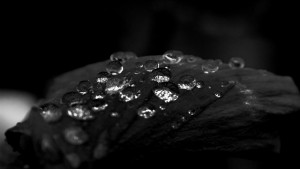Materials scientists look to recreate superhydrophobic coatings in the lab, as potential coatings for waterproof clothing, reflective street signs and self-cleaning solar cells. Current coatings are not strong enough to be used commercially yet. Despite a variety of fabrication techniques, these surfaces share two common features: Superhydrophobic surfaces must be rough and slippery (meaning it’s covered with a hydrophobic coating).
Recently, Robin Ras, at Aalto University in Finland, and colleagues appear to have more computer-related plans for superhydrophobic surfaces.
In June, the researchers wrote letters atop a superhydrophobic surface covered with water, mimicking optical data stored on a CD. They designed the surface to have two superhydrophobic “states.” Switching between the states erased the letters, wiping the visual data.
To create the two superhydrophobic states, the researchers looked to the hairy legs of water striders, insects that skate and jump across ponds. Layers of thin hairs trap a layer of air between the hair and the water, preventing the legs from getting wet and helping the insect float on top of the water.
To mimic this structure, the researchers built a silicon surface with two sizes of fibers. First they etched relatively large cylinders (10 micrometers wide, or one-tenth the width of a human hair) into the wafer. Then they covered these cylinders with tiny nanoscale silicon fibers. A slippery hydrophobic coating covered these nanofibers.
To write the watery memory, the researchers submerged the patterned silicon wafer in water. The water first floats on a cushion of air surrounding the large cylinders. Then a specially designed narrow nozzle pushes the water between the posts. This compresses the layer of air so it hugs the tiny fibers rather than the large cylinders. This new superhydrophobic state changes reflectance of surface, allowing the researchers to read what they’ve written. They erase the data by tugging on the water with the nozzle so it floats on top of the large cylinders again (Proc. Natl. Acad. Sci., DOI: 10.1073/pnas.1204328109).
Last week, Ras and his colleagues demonstrated another kind of water-based memory, called flip-flop memory, using water droplets zipping along superhydrophobic channels carved in a copper plate.
Flip-flop memory changes state every time it’s addressed. In this water example, a water droplet sits at the end of a superhydrophobic channel. Under the right conditions, an incoming water droplet bounces into the resting drop, sending it zipping down another channel (Adv. Mater., DOI: 10.1002/adma.201202980). The collisions resemble that of billiard balls, if the cue ball stopped rolling when it hit a new rack of balls. And the water memory can flip 100 times without a mistake.
They also patterned the channels to create logic gates, where droplet collisions affect their output path.
Here’s an example:
These water devices are only one way that the natural world influences technology design. To learn more about biomimicry influences concrete, solar cell design and train aerodynamics, check out these articles:
Janine Benyus: The promise of biomimicry, TED talk, 2005
Mother Nature as Engineer: 9 Design Tricks Borrowed From Biology, wired.com
Biomimicry: Beaks on trains and flipper-like turbines, BBC
